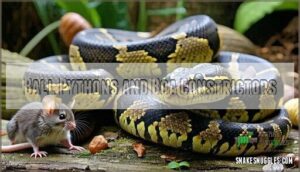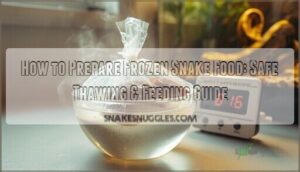This site is supported by our readers. We may earn a commission, at no cost to you, if you purchase through links.
 Learning how to feed a snake with variety isn’t just about mixing up mealtime – it’s about keeping your scaly friend healthy and happy.
Learning how to feed a snake with variety isn’t just about mixing up mealtime – it’s about keeping your scaly friend healthy and happy.
You can offer different rodent types like mice, rats, and gerbils, or branch out to quail, chicks, and fish depending on your snake’s species.
Different prey colors and sizes add mental stimulation while preventing nutritional deficiencies.
Always choose frozen-thawed options over live prey for safety, and research what’s appropriate for your specific snake species.
The secret isn’t just what you feed, but how you present it to spark their natural hunting instincts.
Table Of Contents
- Key Takeaways
- Feeding Snake Varieties
- Feed Snake With Variety
- Safe Food Sources Matter
- Alternative Prey Options
- Optimal Snake Feeding
- Frequently Asked Questions (FAQs)
- What not to do when feeding a snake?
- How do you properly feed a snake?
- How to get a picky snake to eat?
- Should you feed your snake in a different enclosure?
- Do snakes need variety in their diet?
- How to feed a picky snake?
- What do you do if your snake refuses to eat?
- How often should I feed my snake?
- What are some signs my snake is stressed?
- How do I know if my snake is full?
- Conclusion
Key Takeaways
- Rotate your prey types – Mix mice, rats, chicks, and quail to prevent nutritional deficiencies and keep your snake mentally engaged, just like they would encounter in the wild.
- Always choose frozen-thawed over live prey – You will eliminate injury risks from bites while maintaining nutritional quality and reducing stress for both you and your snake.
- Research your specific species’ needs – Different snakes have unique dietary requirements, so understand what is appropriate for your pet before introducing new food varieties.
- Use scenting and presentation techniques – Trigger your snake’s natural hunting instincts by varying prey colors, warming food properly, and using scents like tuna juice for picky eaters.
Feeding Snake Varieties
You’ll want to offer your snake different types of prey to keep them healthy and engaged.
Variety in feeding mirrors what snakes experience in the wild and helps prevent nutritional gaps that could affect their long-term health.
Nutritional Variety
Variety is the spice of life for snakes too.
Different prey offers varied nutrients your pet needs for peak health. Rotating between mice, rats, and appropriate alternatives creates dietary enrichment that supports balanced nutrition.
Variety keeps your snake’s diet exciting while delivering complete nutrition naturally.
Each prey type brings unique vitamins and minerals, helping meet your snake’s nutritional requirements naturally without relying heavily on supplementation needs. This approach ensures your pet receives a broad spectrum of nutrients, contributing to peak health.
Preventing Deficiencies
Despite your best efforts with snake feeding variety, nutrient imbalances can still sneak up on you.
Rotating between different prey types prevents deficiencies that single-food diets create. Your reptile’s gut health depends on this dietary rotation.
- Monitor for signs of calcium deficiency like soft bones or tremors
- Consider supplementation strategies when prey variety isn’t enough
- Track hydration importance since dehydrated prey lacks essential nutrients
Mental Stimulation
Enrichment techniques through varied feeding transform your snake’s mealtime into exciting mental workouts.
Different prey types create cognitive benefits by challenging your pet’s problem-solving skills and promoting behavioral diversity.
| Enrichment Method | Mental Benefits |
|---|---|
| Prey Size Variation | Enhanced decision-making skills |
| Texture Changes | Improved sensory processing |
| Scent Rotation | Increased hunting simulation engagement |
| Environmental Placement | Boosted spatial awareness |
This snake feeding variety keeps minds sharp while addressing natural feeding challenges through diverse sensory input.
Snakes, being strict carnivores, benefit substantially from understanding their carnivorous feeding habits.
Mimicking Natural Behavior
Wild snakes don’t get room service—they hunt, stalk, and adapt to whatever prey crosses their path.
Your snake’s dinner shouldn’t be predictable—variety keeps them sharp and healthy.
Your snake feeding variety should mirror this natural diet through hunting simulation and enrichment techniques.
Rotate prey sizes, colors, and species to trigger behavioral cues, keeping your serpent mentally sharp while honoring environmental factors that shape natural snake diet and feeding behavior patterns.
Feed Snake With Variety
Snake nutrition doesn’t have to be boring, and your pet will thank you for mixing things up. A varied snake diet keeps feeding interesting while ensuring proper nutrient diversity across different prey items. Think of it like a buffet rather than the same meal every night.
Here’s how to add variety effectively:
- Rotate prey species – Mice, rats, quail, and chicks offer different nutritional profiles that support overall health
- Adjust prey size gradually as your snake grows, matching feeding frequency to snake age and metabolism needs
- Source ethically from reputable suppliers who prioritize animal welfare and quality control standards
Your snake’s wild cousins don’t eat identical meals daily, so why should yours? Remember that calcium is essential for bone health.
Start slowly with one new prey type per month, watching how your snake responds. Some snakes are picky eaters, while others embrace change enthusiastically. Remember that sourcing ethics matter just as much as variety – choose suppliers who maintain high standards for their animals.
Safe Food Sources Matter
When you’re choosing food for your snake, the source matters just as much as the variety you offer.
Safe, high-quality prey from reputable suppliers keeps your pet healthy while giving you peace of mind about what’s going into their diet.
Frozen/Thawed Preference
Frozen-thawed prey offers significant advantages over live feeding for snake health and safety.
You’ll reduce injury risks while maintaining nutritional quality through proper thawing methods and warming techniques.
| Aspect | Frozen/Thawed Benefits |
|---|---|
| Safety | Eliminates bite wounds and stress |
| Storage | Long-term freezer storage convenience |
| Nutrition | Preserves essential nutrients when thawed properly |
| Cost | Bulk purchasing reduces feeding expenses |
Ethical Sourcing
You’ll want to choose suppliers who put humane breeding and prey welfare first when selecting snake food options.
Sustainable practices and supplier transparency guarantee your pet’s dietary variety comes from ethical sources. Many owners seek ethical snake food to guarantee responsible feeding.
- Certified breeders who maintain clean, spacious facilities for rodent colonies
- Transparent suppliers who openly share their breeding methods and animal care standards
- Sustainable operations that prioritize environmental responsibility in their production
- Ethical alternatives like pre-killed frozen options from reputable snake feeding companies
Avoiding Live Food
Live feeding poses serious risks to both you and your snake.
Rodents can bite and injure your pet, creating wounds that lead to infections.
Humane alternatives like frozen-thawed prey eliminate these dangers while ensuring prey safety.
Ethical concerns around live feeding make diverse snake prey options more appealing.
These alternative snake meals provide the same nutrition without stress or injury risks.
Some owners opt for frozen-thawed prey for its safety and convenience, making it a preferred choice for many, due to the reduced risk of injury.
Species-Specific Research
Research your snake species thoroughly before choosing their menu. Different snake diets require specific prey sizes and nutritional needs based on their natural feeding habits.
Understanding your pet’s background helps create proper habitat simulation through dietary enrichment. A balanced diet is essential to avoid metabolic bone disease.
- Ball pythons thrive on appropriately-sized rodents matching their gape width
- Garter snakes benefit from fish and amphibians reflecting their wild diet
- Corn snakes accept varied prey but need consistent reptile nutrition guidelines
- Specialized feeders like egg-eating species require unique nutritional requirements
Veterinarian Consultation
Every responsible snake owner should schedule regular vet consultations to guarantee superior reptile nutrition and health monitoring.
Expert snakecare professionals can assess your snake’s diet, recommend species-specific feeding schedules, and catch potential issues early through preventative care.
Vet importance can’t be overstated when establishing proper snake care routines for your pet’s wellbeing, and it is crucial for reptile nutrition and overall health monitoring.
Alternative Prey Options
Different snake species have unique dietary preferences that go beyond the standard mouse or rat.
You’ll find that corn snakes thrive on mice and small birds, while garter snakes prefer fish, frogs, and earthworms alongside traditional rodents.
Corn, Rat, King, and Milk Snakes
Your corn snake diet works best with variety beyond basic rodents. These adaptable species naturally hunt diverse prey that keeps them healthy and engaged.
- Corn snake diet: Mice, rats, and occasional chicks provide essential nutrition variety
- Rat snake prey: Larger rodents, birds, and eggs suit their bigger appetites perfectly
- King snake needs: Multiple prey types including other snakes, lizards, and bird eggs
- Milk snake food: Smaller rodents, chicks, and quail eggs match their modest size requirements
To guarantee the best nutrition, consider incorporating whole prey items into their diet.
Garter and Water Snakes
Garter and water snakes thrive on diverse diets that mirror their wild eating habits.
You’ll want to offer earthworms, appropriate fish like salmon, and frozen/thawed rodents to meet their aquatic needs.
This variety supports habitat enrichment while preventing nutritional deficiencies.
Remember, these snake feeding tips help maintain proper temperature regulation and support their natural brumation cycle, keeping common ailments at bay.
Ball Pythons and Boa Constrictors
Ball pythons and boa constrictors make feeding time exciting with their appetite for diverse prey.
These constrictors thrive on rats, mice, African soft-furred rats, chicks, and quail.
Python husbandry benefits from variety—it prevents nutritional deficiencies and stimulates natural feeding behavior.
Size differences matter: juveniles need smaller prey more frequently than adults.
This dietary diversity supports snake health while addressing breeding challenges through proper nutrition and enclosure enrichment.
The proper care of these animals is crucial for their well-being, and understanding their dietary diversity is key to successful snake husbandry.
Optimal Snake Feeding
Creating the perfect feeding routine for your snake takes more than just dropping food in their enclosure once a week.
You’ll want to master techniques like color variation, stress reduction, prey switching, and scenting to keep your serpent friend thriving and engaged.
Color Counts: Offering Different Prey Colors
When you’re offering different prey colors, you’re basically creating visual stimulation that triggers your snake’s natural hunting response.
Prey pigmentation matters more than you’d think – some snakes show distinct color preferences based on their wild diet.
This variety enhances reptile food enrichment while supporting proper feeding techniques.
Whether using frozen prey or live options, rotating between white, brown, and gray rodents can boost nutritional impact and maintain your snake’s interest in feeding.
Reduce Stress: a Key to Feeding
Stressing out your snake can kill its appetite faster than you’d think.
Creating a calm environment with proper temperature and secure enclosure is vital for successful snake feeding behavior. A secure enclosure should include a safe place to hide.
- Maintain consistent feeding schedule to reduce anxiety
- Use gentle handling techniques before feeding sessions
- Ensure ideal snake feeding environment with hiding spots
- Minimize disturbances during feeding time for better snake feeding enrichment
Switch It Up: Variety in Prey
Rotating between different prey types keeps your snake mentally engaged while promoting peak health.
Think of it as creating a buffet experience – mice one week, rats the next, then perhaps quail or chicks.
This reptile food enrichment approach guarantees Nutritional Balance and prevents boredom.
Different snake prey offers varying textures and nutrients, making Enrichment Feeding more effective than monotonous meals.
For safety, it’s best to use frozen-thawed prey to ensure a healthy and safe feeding practice, promoting peak health and preventing issues through reptile food enrichment.
Scenting: Triggering Appetite
When your snake turns finicky, scenting techniques can work like magic.
Enhanced smells from prey scenting using tuna juice, egg, or commercial scent sprays trigger hunger stimulation through their powerful sense of smell.
This scent introduction method helps with feeding snakes, especially picky eaters.
Consider using specialized scenting products to further entice feeding.
Try rubbing preferred prey scents onto food items—these feeding tips make snake feeding and reptile feeding much more successful.
Frequently Asked Questions (FAQs)
What not to do when feeding a snake?
Over 70% of captive snakes die from feeding mistakes.
Don’t handle live prey carelessly, feed oversized meals, use wild-caught rodents, feed too frequently, or skip proper thawing of frozen food—these errors cause serious health problems.
How do you properly feed a snake?
Use appropriate prey size (10-20% of snake’s body weight), feed juveniles every 5-7 days and adults every 10-14 days, and offer pre-killed frozen-thawed prey in a secure, separate feeding container.
How to get a picky snake to eat?
Stubborn eaters versus enthusiastic feeders?
Try offering pre-killed prey at different temperatures, switching prey types, or creating a secure hiding spot.
You can also try feeding at night when they’re most active.
Should you feed your snake in a different enclosure?
You’ll want to keep your snake in its regular home for feeding.
Moving them to separate containers causes unnecessary stress and can actually make them refuse food.
Stick to their familiar territory.
Do snakes need variety in their diet?
Picture a wild python gracefully hunting diverse prey across forest floors.
Your snake doesn’t need variety like we do—they’re perfectly content eating the same appropriate prey consistently throughout their lives.
How to feed a picky snake?
Picky snakes often respond better to pre-killed prey that’s been warmed to body temperature.
Try different prey sizes, scenting with their favorite food, or offering meals in complete darkness when they’re most comfortable feeding.
What do you do if your snake refuses to eat?
Check if your snake’s tank temperature is right—they won’t eat if it’s too cold.
Try offering food at night when they’re most active, and don’t handle them for several days before feeding.
How often should I feed my snake?
Snakes can survive up to six months without food, but don’t let that fool you.
You’ll need to feed juveniles weekly, adults every two to three weeks depending on species and size.
What are some signs my snake is stressed?
Watch for refusing food, excessive hiding, irregular shedding, defensive posturing, or constant movement.
Your snake might also show changes in breathing patterns, unusual body positioning, or decreased activity levels when stressed.
How do I know if my snake is full?
Your snake’s full when you see a visible bulge in its body where the prey item is located.
The bulge should be noticeable but not overly large, and your snake will typically become less active and seek a quiet spot to digest its meal.
Conclusion
Don’t put all your eggs in one basket regarding your snake’s diet.
Learning how to feed a snake with variety guarantees your pet stays healthy, engaged, and satisfied.
By rotating between different prey types, sizes, and colors, you’ll prevent nutritional gaps while keeping feeding time interesting.
Remember to stick with frozen-thawed options, research your species’ specific needs, and consult your vet when trying new foods.
Your snake will thank you with better health and natural behaviors.
- https://docs.google.com/forms/d/1GAQr3Kn1cURCVHUA82hAga1Wv8DCH0IuqDLRUrOpN7M/viewform?ts=63f4f653&entry.1515682415=https://www.merriam-webster.com/dictionary%2Ffeed
- https://premium.britannica.com/mw-unabridged/?utm_source=mw&utm_medium=inline-def&utm_campaign=evergreen
- https://www.facebook.com/feedprojects/
- https://www.instagram.com/feed/
- https://www.pinterest.com/feedprojects/
















